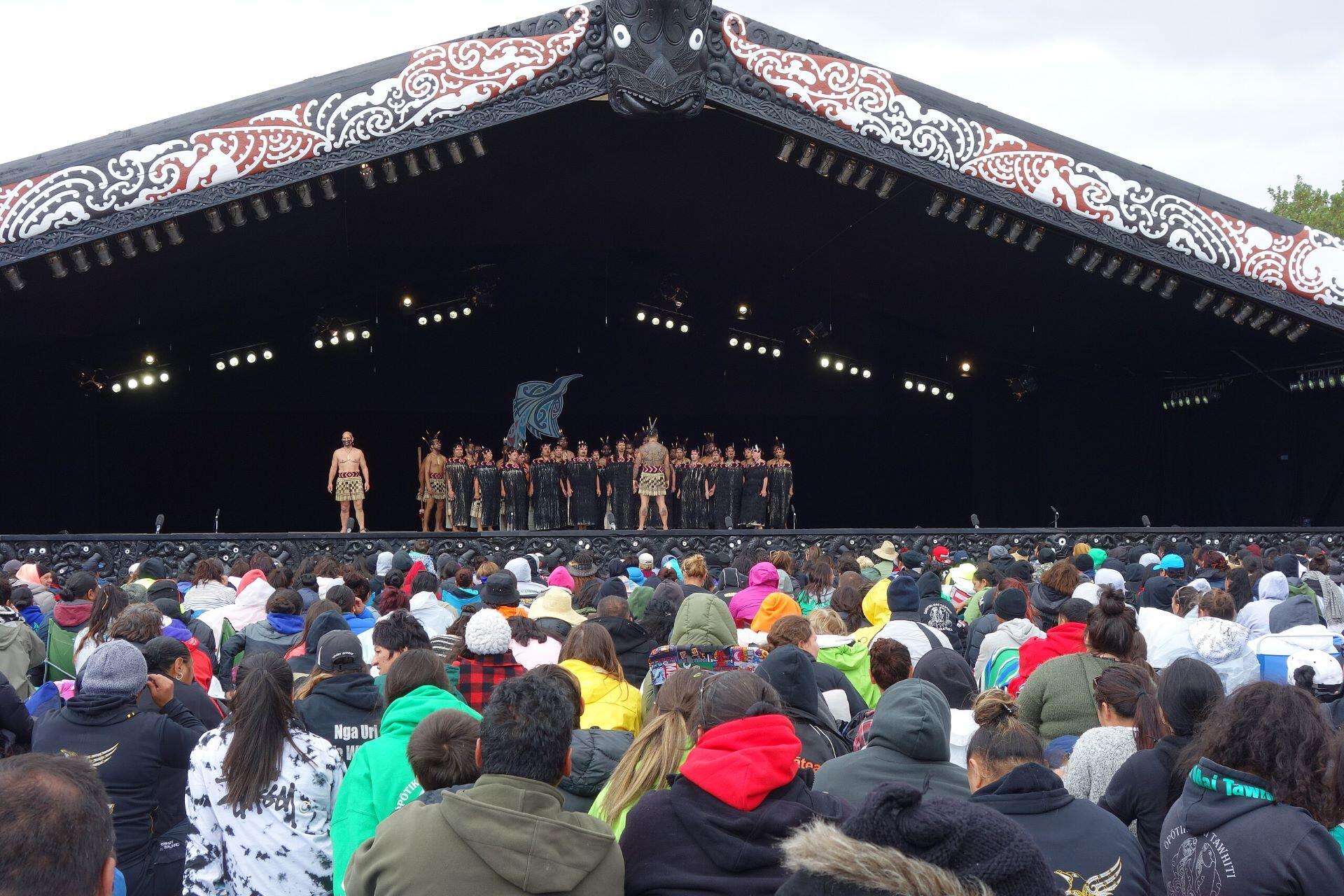Te Matatini is New Zealand's premier Māori performing arts festival. It showcases the beauty, power, and storytelling of kapa haka. Held every two years, it brings together the best kapa haka groups from across the country.
The name "Te Matatini" literally means "the many faces", reflecting the diverse range of participants who share their cultural identity. This celebration of Māori heritage, language, and artistry includes thousands of performers and spectators who gather to witness haka, waiata, and cultural narratives honouring past and present generations.
Here, we'll explore the origins, structure, and cultural significance of Te Matatini, highlighting recent winners and why the festival is still a cornerstone of modern Māori identity.

What is Te Matatini?
Te Matatini is a prestigious Māori arts festival held in New Zealand to celebrate the rich traditions of kapa haka. Meaning "the many faces", Te Matatini symbolises the diversity of the groups and performers while uniting them in their shared culture, language, and history.
Te Matatini provides a platform for kapa haka groups, or rōpū, to showcase their skills in haka, waiata, and other traditional Māori performing arts. These art forms are a powerful combination of storytelling, synchronised movements, and vocal harmonies that express history, cultural narratives, and whakapapa (genealogy).
The festival has several purposes. For one, it's a competition in which groups strive for excellence. It's also a cultural gathering to celebrate Māori identity and a learning experience for performers and audiences.
Beyond the performances themselves, Te Matatini is also important for preserving te reo Māori (the Māori language) while also reinforcing the Māori cultural values of mana, whanaungatanga (relationships), and tapu (sacredness).
The festival is held biennially (every two years) by different regions across Aotearoa (New Zealand) and is a symbol of national pride, uniting people in the spirit of cultural appreciation.
The History and Origins of Te Matatini
Te Matatini's history officially dates back to 1972, when it was known as the Polynesian Festival. It was created to unite the various cultural groups across Aotearoa and celebrate Māori performing arts alongside other Polynesian performances.
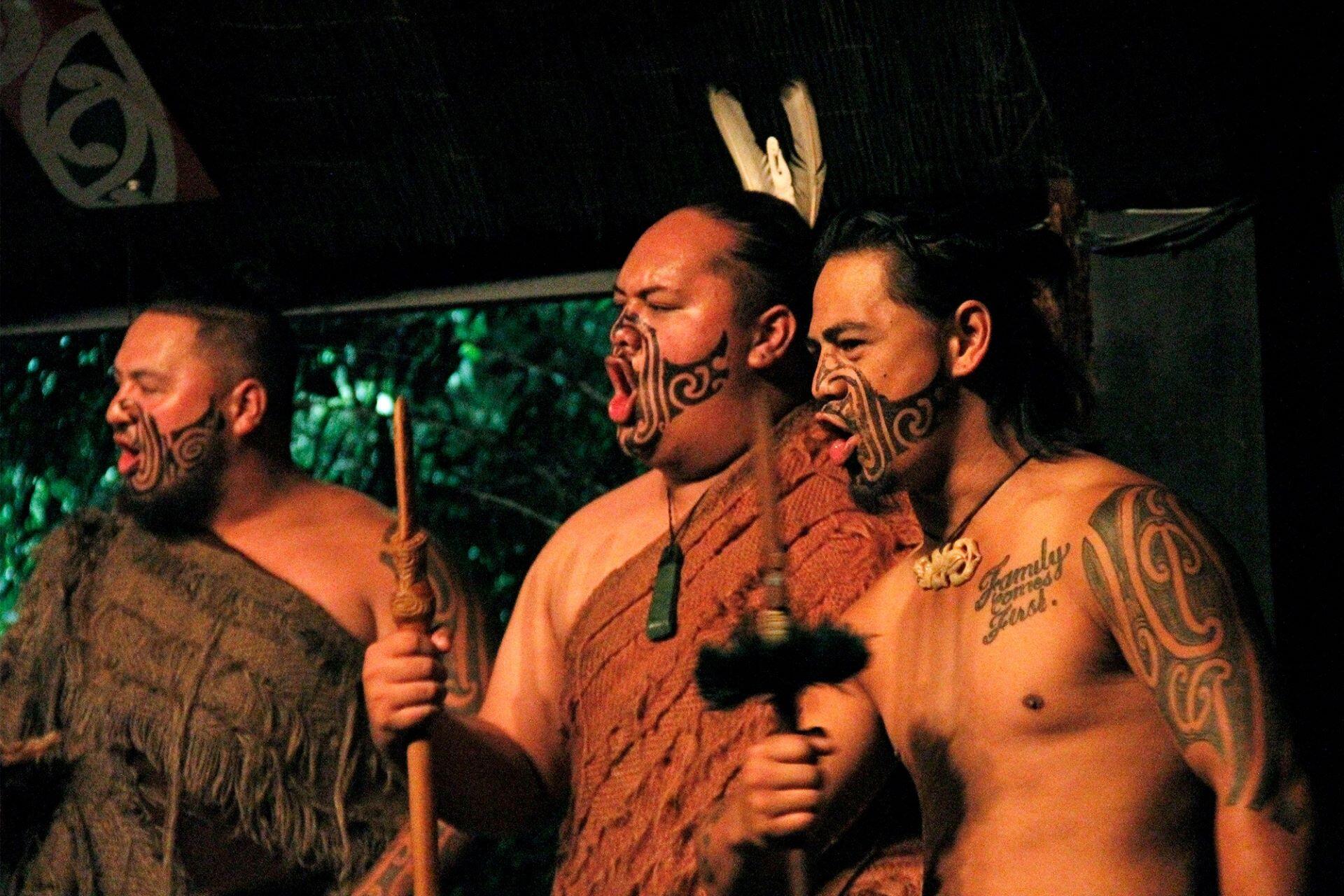
By the end of the 1970s, however, the festival's focus had shifted exclusively to kapa haka. There was a growing movement to preserve and promote Māori language, customs, and identity.
The festival became more structured and competitive in the following years, emphasising haka, waiata, and whakawātea.
In 2004, the festival was renamed Te Matatini to emphasise the unity and diversity it showcased and the shared expression of Māori identity.
It's grown in size and influence, attracting tens of thousands of participants and spectators every two years.
Key Milestones
- 1972: First festival held in Rotorua under the name Polynesian Festival.
- 1979: Shifted focus exclusively to kapa haka.
- 2004: Officially renamed Te Matatini.
- 2023: Record participation with over 50 groups and more than 70,000 attendees.
Speaking of records, did you know that New Zealand regained the haka world record recently?
Te Matatini has evolved from a small cultural gathering into a national platform celebrating Māori excellence in performance and identity.
Thanks to the festival, new generations have been inspired, ensuring that Māori performing arts continue to be celebrated nationwide.
If you find Te Matatini fascinating, you may also be interested in pōwhiri, a traditional welcoming ceremony.

The Structure of the Festival
Te Matatini honours cultural, traditional, and competitive excellence across Aotearoa. The festival is the premier kapa haka showcase and is organised to ensure the values of mana (honour), whanaungatanga (relationships), and tapu (sacredness) are upheld.
Here's how the festival is structured.
Regional Competitions and Selection Process
Te Matatini really begins with the regional competitions held throughout New Zealand. Groups from different regions compete to honour and represent their iwi (tribes) and communities.
Only the best groups from these regional events will advance to the Te Matatini finals.
Festival Format
The festival is held across several days, with different stages of the event held on different days.
Day One and Two – Pool Performances
- Groups are divided into pools and perform over the first two days.
- Each group presents a full kapa haka set, including haka, waiata, poi, and whaikōrero (oratory).
Day Three – Semi-Finals
- Top groups from the pool performances advance to the semi-finals.
- Judges assess performances based on technical skill, cultural integrity, and storytelling.
Day Four – Finals and Prize Giving
- The highest-scoring groups compete for the top honour.
- Awards are presented for overall excellence and specific performance elements like haka, waiata, and poi.
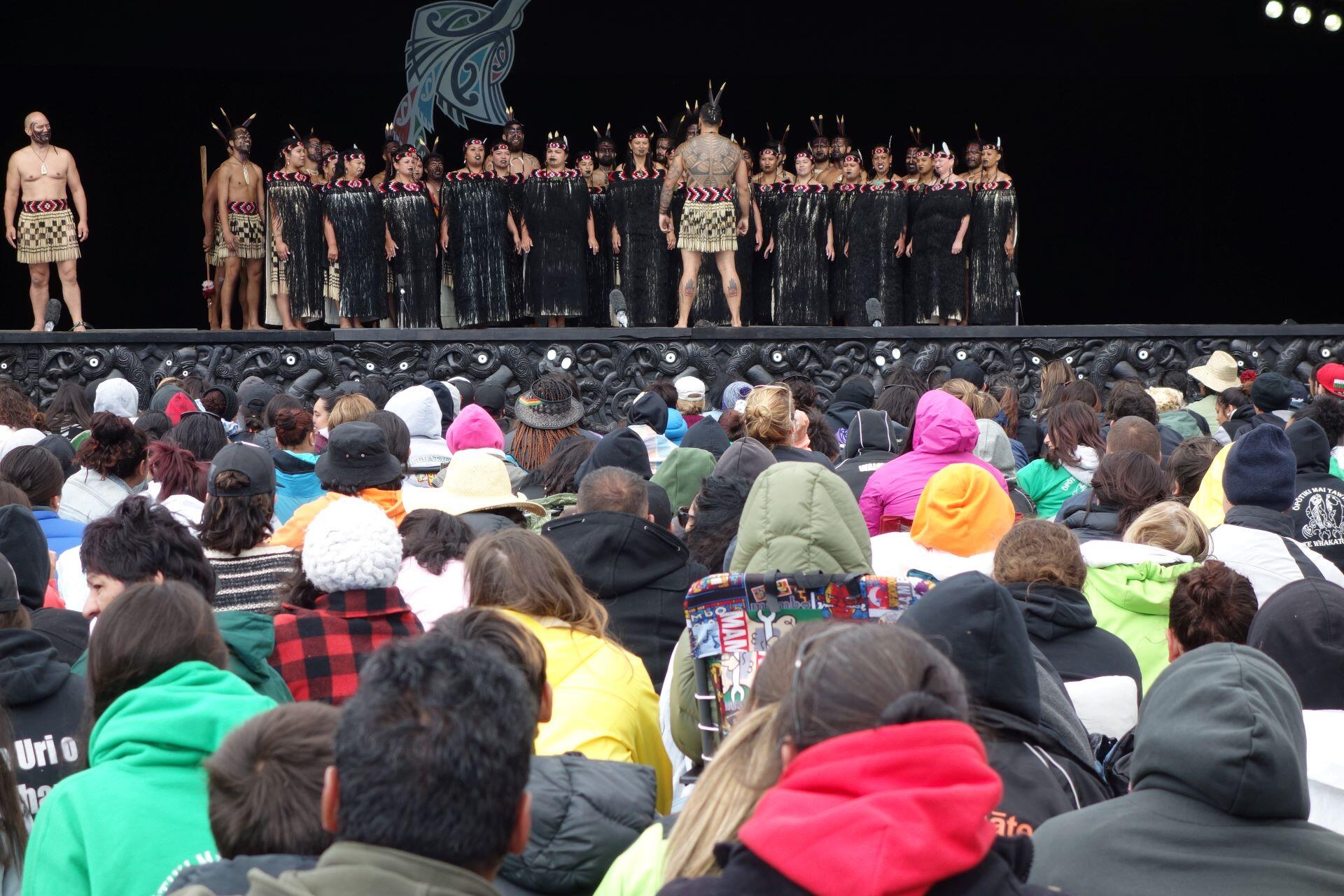
Judging Criteria
Throughout the event, performances are judged and evaluated using several criteria.
- Technical Mastery: Precision in movement, vocal strength, and synchronisation.
- Cultural Integrity: Correct use of te reo Māori and adherence to traditional protocols.
- Storytelling Impact: Ability to convey meaningful narratives through performance.
Te Matatini’s structure ensures that performances not only entertain but also educate, preserving the richness of Māori cultural expression.
Key Elements of Kapa Haka Performance
The art of kapa haka is at the heart of Te Matatini. This expressive form of Māori performing arts that combines song, dance, and storytelling. Every kapa haka group, or rōpū, will deliver a structured performance comprising various elements of cultural significance and storytelling.
1. Haka (Posture Dance)
The haka is probably one of the best-known parts of kapa haka for those outside Māori culture, particularly the haka performed by the All Blacks before their matches.
This powerful and rhythmic war dance includes synchronised movements, foot-stomping, hand gestures, and fierce facial expressions such as the pūkana (eye-widening).
Purpose:
- Express cultural identity, pride, and defiance.
- Communicate historical narratives and honour ancestors.
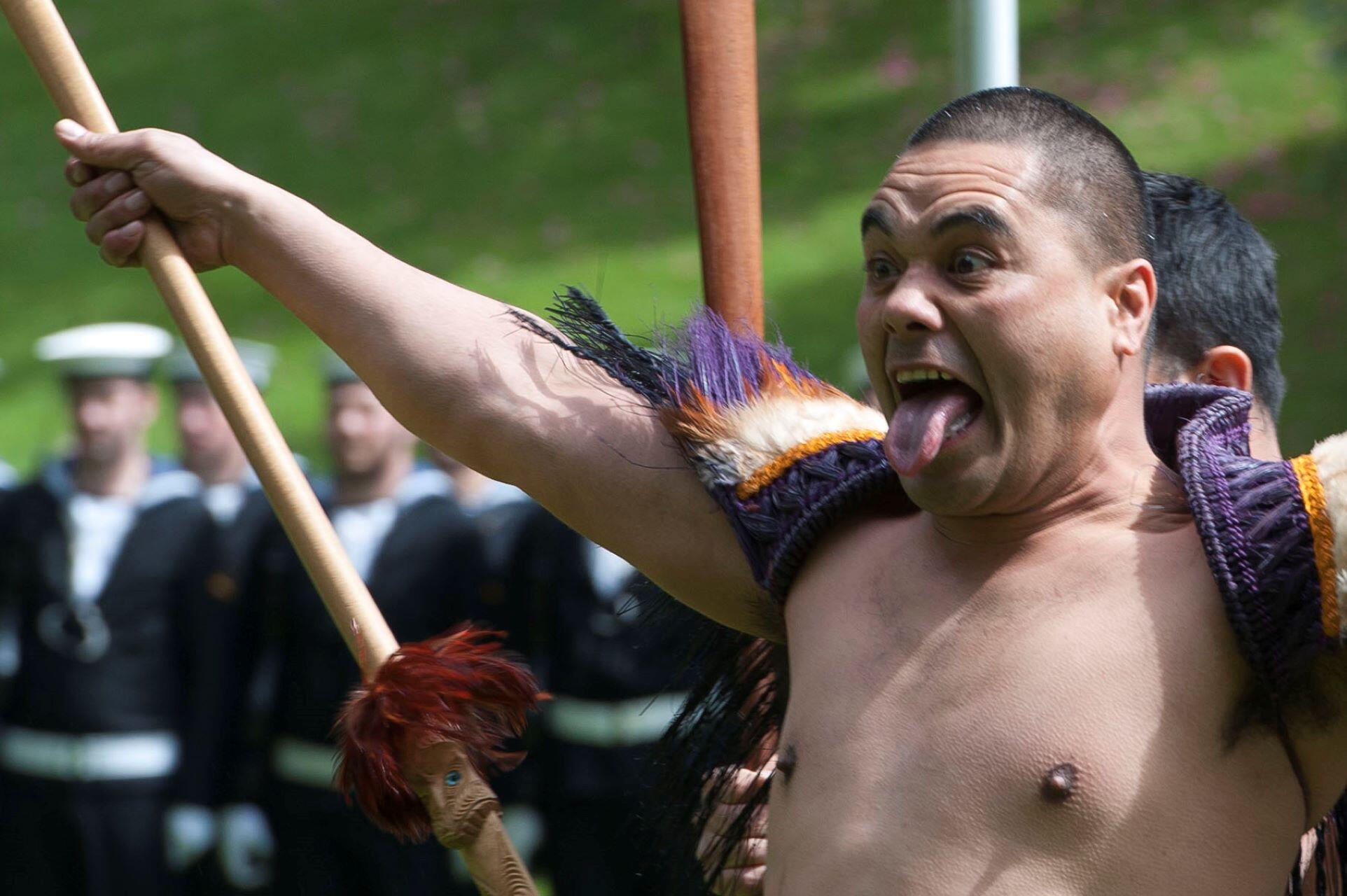
2. Waiata-ā-ringa (Action Songs)
The waiata-ā-ringa involves synchronised singing with hand gestures representing the song's lyrics. This lyrical performance combines storytelling and melodic harmonies that often represent cultural pride, love, or historical events.
Purpose:
- Celebrate beauty and unity through song.
- Convey messages of love, remembrance, and peace.
3. Poi (Rhythmic Ball Dance)
The poi is when performers swing tethered balls while singing. Requiring precision and grace, these movements often represent or reflect natural elements like waves or birds in flight.
Purpose:
- Originally used to develop wrist flexibility for warriors.
- Now, it is a storytelling tool showcasing skill, grace, and rhythm.
4. Whakawātea (Exit Performance)
The whakawātea is the final element of the performance and is done as the group exit the stage. It usually combines elements of haka, waiata, and the spoken word. A powerful conclusion to the performance.
Purpose:
- Mark the completion of the performance.
- Reinforce key messages or themes presented during the set.
5. Whaikōrero (Oratory)
The whaikōrero is the formal speech component delivered by the designated male speaker. It reflects traditional Māori storytelling and oral history practices.
Purpose:
- Share ancestral knowledge, cultural wisdom, and historical context.
Each element of kapa haka reflects the depth and diversity of Māori cultural expression, combining performance art with storytelling, identity, and history.
Cultural Significance and Impact
Te Mataini is hugely important for Māori communities. It celebrates their heritage and offers a platform for cultural preservation. It's not just a national competition; it reflects the core values and beliefs of Māori culture.
1. Preservation of Te Reo Māori (Māori Language)
Language is key to kapa haka performances. Performers use te reo Māori in waiata, haka, and whaikōrero.
The festival plays a key role in revitalising the Māori language by:
- Encouraging fluent speakers and learners to engage with te reo Māori in a powerful, artistic setting.
- Inspiring younger generations to learn the language through music and performance.
Te Matatini promotes the continued growth of te reo Māori, ensuring the language thrives across generations.
2. Honoring Whakapapa (Genealogy)
Kapa haka performances typically include stories of whakapapa (ancestral lineage), connecting performers to their tribal history and spiritual heritage.
Te Matatini gives groups a platform to:
- Share the history of their iwi (tribes) and tūpuna (ancestors).
- Maintain cultural knowledge through oral storytelling.
- Reinforce the connection between whenua (land) and identity.
3. Strengthing Mana
Participating in Te Matatini brings a profound sense of mana (prestige and honour) to both performers and their communities.
By providing a national stage, groups can:
- Represent their iwi and regions with pride.
- Gain recognition for artistic excellence and cultural leadership.
- Inspire future generations by exemplifying cultural strength and skill.
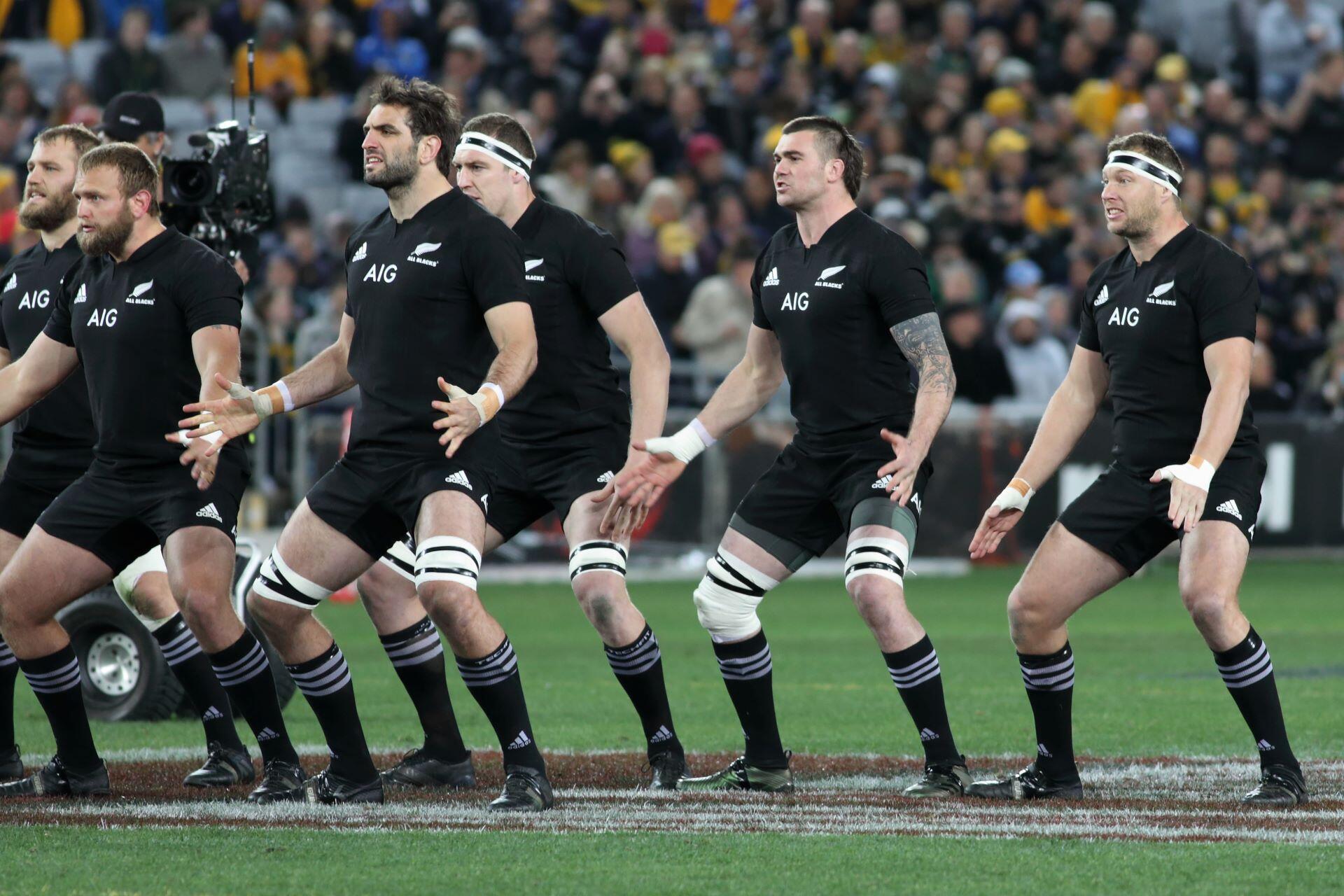
Recent Winners and Notable Performances
Te Matatini has showcased the talent of many kapa haka groups across Aotearoa, but only one gets the honour of being the competition's winner.
Here are the most recent winners and the region they hailed from.
| Year | Winner | Region |
|---|---|---|
| 2023 | Te Kapa Haka o Te Whānau a Apanui | Mātaatua |
| 2019 | Ngā Tūmanako | Tāmaki Makaurau |
| 2017 | Whāngārā Mai Tawhiti | Te Tairāwhiti |
| 2015 | Te Whānau a Apanui | Mātaatua |
| 2013 | Te Waka Huia | Tāmaki Makaurau |
| 2011 | Te Mātārae i Ōrehu | Te Arawa |
| 2009 | Te Waka Huia | Tāmaki Makaurau |
One of the most memorable performances recently came from the Te Kapa Haka o Te Whānau a Apanui, the 2023 champions.
Watch it here.
This is an elite level of performance.
Winning Te Matatini is a symbol of cultural excellence, with groups competing not only for awards but to represent the strength and beauty of Māori identity.

